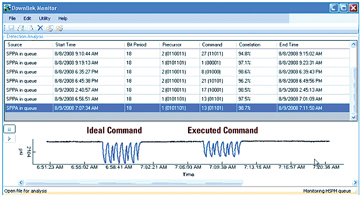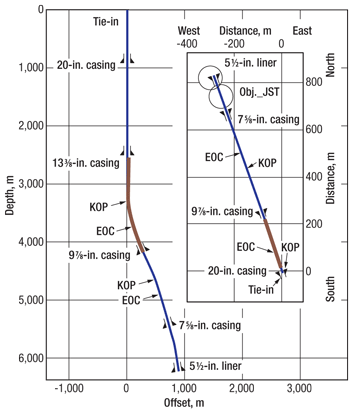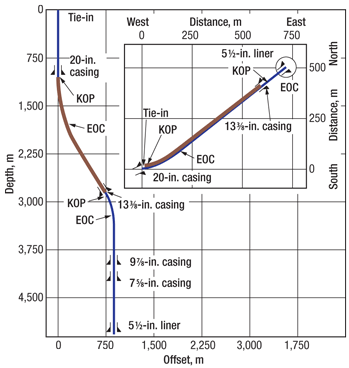A two-well field trial for Pemex demonstrated the hybrid technology incorporating RSS and remote control of mud pumps.
J. Leonardo Colón, Petróleos Mexicanos; Alexis Castro Juin, Hernan Melgares and Cesar Velez Terrazas, Schlumberger
An innovative automated method for drilling directional wells remotely was successfully deployed in southern Mexico for Petróleos Mexicanos (Pemex) during 2008. Remote automated directional drilling combines two enabling technologies—rotary steerable drilling and remote control of the rig’s mud pumps—to allow the directional drillers to steer the drillbit to its geological target remotely from an offsite office.
All steering commands are executed by using the mud pump controls to create coded pressure pulses in the mud column that are detected and interpreted by the Rotary Steerable System (RSS). The RSS, in turn, makes the necessary toolface adjustments to execute the command.
This technique, called downlinking, was previously performed manually at the rig by the directional driller. As with many manual functions, different rig consoles, different hands on the pump control valve and slightly different timing sometimes result in missed commands because pulse sequences could not be interpreted by the downhole tools. Part of the new remote actuation system is automated pulse generation, so all downlink commands are uniform and of maximum quality. For the two-well trial described here, implementation of remote automated directional drilling with automatic pulse-code generation resulted in a 90% downlink success rate, up from an average of around 70%, resulting in better quality holes and smoother trajectories, Fig. 1.
 |
|
Fig. 1. The real-time downlink monitor allows the directional driller to observe downlink effectiveness and quality by comparison with an ideal signal.
|
|
ENABLING TECHNOLOGIES
Since, by definition, a rotary steerable system is constantly rotating, there is no need to stop the drillstring rotation in order to shift to sliding mode while making inclination or direction changes, as is necessary when drilling with mud motors and bent subs. This means that the driller and his crew on the rig floor only need to keep turning to the right, stopping occasionally to make a connection.
On one of the first RSS-drilled wells, located in southern Mexico, the change in average Rate Of Penetration (ROP) was quite dramatic—from 295 ft/day to 558 ft/day (90 m/d to 170 m/d)—just from eliminating slide drilling with motors.
On the remote directional drilling field trial for Pemex, RSS technology improvements helped improve ROP and borehole trajectory quality. One such improvement was automatic hold on inclination and azimuth through the use of a closed-loop control system. This feature allowed directional drillers to program their tools to drill a pre-set well profile, intervening only if the bit began to move off track. Directional driller productivity was positively impacted.
Downlinking improvements. Remote directional drilling is largely made possible by recent improvements in the range and efficiency of downlink commands, due to improved transmission capabilities with much better signal-to-noise ratios. Nowadays, downlinking can be effectively carried out at a surface-to-tool distance of more than 40,000 ft (12,200 m), and steering changes can be implemented without interruption of drilling. Signal clarity is improved by automatic pulse generation techniques, which are also a key enabler of remote direction drilling.
Control and monitoring of steering commands. For the field trial, a new mud pump control system was introduced to automate the pulse generation process. The system eliminated human error by removing the risk that an incorrect series of pulses could be sent downhole in manual operation. It also allowed steering commands to be sent to the RSS without disturbing the driller. System redundancy allows steering commands to be sent from the rig logging unit or remotely, from the drilling center. This provides a backup system in case of an interruption in office-to-rig communication. The directional driller can contact the LWD engineer, who can issue the steering commands from the field unit.
A unique quality control system allows the directional driller to monitor the actual command sent downhole and compare it with an idealized sequence. It also indicates whether the steering command has been received and properly acted upon.
Onsite override. Before Pemex’s rig crews would accept the idea of remotely controlling the mud pumps, they had to be convinced that the driller on the rig floor had ultimate control of the pumps. To answer this concern, the service company included a positive override capability for the driller. No matter what the remote directional driller is doing or trying to do from the office, the driller onsite can override it if local control of the mud pumps is required for any reason.
FIELD TRIAL
Two wells in southern Mexico were selected to test the ability to reliably and safely steer a directional well from the office. The first well was located 94 mi (150 km) from the nearest town and had its vertical section drilled and cased to 7,872 ft (2,400 m). The initial directional section would encounter extremely hard sandstone with bulk compressibility peaking to 23,700 psi, which had caused very low ROP of 4.20 ft/hr (1.27 m/hr). In addition, the section consisted of alternating hard and soft streaks, which cause destructive bit vibration and abnormal bit wear. In a nearby offset well, four bits were needed to negotiate the section, and high mud weights up to 16.9 ppg (2.02 g/cc) threatened the ability to transmit clear manual downlinks at depth.
Pemex’s drilling department selected Schlumberger’s PowerDrive vorteX rotary steerable drilling system, which augments top-drive rotation by including a straight mud motor just above the RSS. This allows the bit to be rotated at very high speed, using torque to overcome hard formations, while the surface equipment only needs to rotate the drillstring quickly enough to ensure effective hole cleaning. The system effectively suppressed stick-slip vibration, and, in this application, allowed the 12¼-in. hole section to be drilled in a single bit run.
In the first test, the 12¼-in. directional hole section was drilled shoe-to-shoe from 7,842 ft to 13,838 ft (2,200 m to 3,300 m). Inclination was built in the section from 0° to 23°, and azimuth was maintained at about 341°, Fig. 2. During the drilling of the directional section, a total of 21 downlinks were sent to the RSS tool directly from the drilling center in town. Correlation of 98% was achieved between ideal downlink commands and executed sequences, and the entire section was drilled in 170 hr less than the offset well. Throughout, the directional driller was provided with real-time feedback that included—besides standard MWD/LWD data—toolface, downhole weight-on-bit, downhole torque and four-axis vibration. No coordination problems were experienced between the directional driller and the driller at the rig.
 |
|
Fig. 2. Trajectory of the first remotely drilled directional well for Pemex (red indicates remotely drilled section).
|
|
The second test was more challenging, in that the well, located 21 mi (34 km) from town, was in an area known for wellbore stability problems. High torque and drag and sticking of the BHA were also prevalent.
A specific challenge on the second well was identification and avoidance of the salt top. Drilling into the salt posed a strong risk of taking a saltwater kick, which would require rapid buildup of mud weight to control, leading to potential failure of the casing shoe. Uncertainties in the geologic model made the salt top location difficult to predict.
Due to the complex set of issues, Pemex’s drilling department wanted to ensure that directional drilling and wellbore quality issues did not add to the problems. The drilling team concluded that most of its focus must be on managing wellbore stability and geopressured risks, while maximizing ROP to minimize openhole exposure time. Managed-pressure drilling was considered to maintain effective circulation density within the narrow limits of pore pressure and fracture pressure gradients. MWD parameters were as important as LWD data to ensure maximum drilling efficiency along with precise well placement. The team developed efficient workflows that coordinated the efforts of all stakeholders with those of the directional driller.
Real-time data from downhole was streamed into the remote office (a Schlumberger Operation Support Center, or OSC) manned by a multidisciplinary team of experts from both Pemex and Schlumberger. In addition, a specialized drilling optimization crew from Houston was networked in to monitor real-time drilling data on a round-the-clock basis with the objective of helping in the early detection and rapid prevention or mitigation of incidents related to wellbore stability or risky drilling practices.
Close coordination between the directional driller and the rig driller added to the effective operational control of the well construction. While executing steering commands remotely, as in the first test, the directional driller was able to assist the rig driller with timely advice on optimum rotation speed, mud weight and weight-on-bit as indicated by real-time downhole data. The team identified the top of salt in time to adjust mud weight and drilling parameters to avoid saltwater influx and stuck pipe incidents. It also accomplished the timely identification and mitigation of wellbore stability issues and destructive vibration.
As with the first test, the second well was drilled vertically to a casing point at about 3,243 ft (989 m). From that point it was directionally drilled by remote to the next casing point, located at 9,169 ft (2,795 m), by first steering the azimuth about 17° to the left and then building borehole inclination to 33°, Fig. 3. After setting pipe, the remote control system was used to drop inclination back to vertical. The average drilling rate was 349 ft/day (106.5 m/d). Drilling was completed 39% more quickly than the previous best well in the field and 18 days faster than an offset well drilled from the same pad. While offset wells encountered considerable saltwater flow that made it very difficult and time-consuming to run casing, the test well experienced no such problems.
 |
|
Fig. 3. Trajectory of the second remotely drilled directional well for Pemex (red indicates remotely drilled section).
|
|
OPERATIONAL BENEFITS
It was discovered that effective decision-making was facilitated by having the directional driller physically present with the decision team in the OSC. This especially benefited drilling efficiency, by allowing great confidence in steering decisions and in decisions to optimize penetration rates.
Remote directional drilling with RSS also allowed a major improvement in utilization of experienced personnel. Pemex officials were able to reduce the numbers of specialists at the wellsites, and concentrate the company’s geoscience and well construction expertise at the real-time drilling center, eliminating significant nonproductive time associated with transport to and from the rig.
Another quality benefit was experienced when directional drillers found they could use the automatic pulse generator to execute several small, sequential steering changes instead of one big change, thus allowing them to drill smoother trajectories and thereby managing wellbore stability.
Though the onsite override allowed the driller on the rig, if necessary, to override commands from the office, minimal coordination during the field trial allowed the onsite driller and the remote directional driller to perform their functions without interfering with each other. Rig crews reported that they found the remote pump control so unobtrusive that they were hardly aware that downlinking was going on at all. 
ACKNOWLEDGMENT
This article was prepared from a paper presented at the Congreso Mexicano del Petroleo held in Veracruz, Mexico, on May 18, 2009. PowerDrive vorteX and Operation Support Center (OSC) are marks of Schlumberger.
|
THE AUTHORS
|
| |
J. Leonardo Colón is a Directional Drilling Specialist for Pemex, based in Villahermosa, Mexico. He joined Pemex over 24 years ago and has held various field and office positions with the company. He holds a degree in petroleum engineering from the Instituto Politécnico Nacional, Mexico.
|
|
| |
Alexis Castro Juin is Schlumberger’s Sales and Marketing Manager for Mexico and Central America, based in Villahermosa, Mexico. Mr. Castro Juin has 15 years of experience in the oil field. He joined Schlumberger in 1995 and has held positions in Argentina, Brazil, Ecuador and Mexico. He holds a bachelor’s degree in engineering with a bronze medal from the National University of Cordoba, Argentina.
|
|
| |
Hernan Melgares has been a Schlumberger Drilling Engineer for the Mexico South region since 2007. He began his career with Schlumberger in 2001 as a Drilling and Measurements Field Engineer in the Caspian Sea region. In 2003, he moved to Mexico North as a Directional Driller, later working in the drilling engineering group in Mexico East and Ecuador. Mr. Melgares holds a bachelor’s degree in industrial engineering from the Universidad Mayor de San Simon, Cochabamba, Bolivia.
|
|
| |
Cesar Velez Terrazas is the Pemex Account Manager for Schlumberger. Mr. Velez Terrazas has 24 years of experience in the oil field, the last few dedicated to developing new businesses. He holds a degree in industrial chemical engineering from the Instituto Tecnológico de Chihuahua, Mexico, and a master’s degree in marketing from the Universidad del Valle de México. In addition, he is a coach certificated by the International Coaching Community.
|
|





